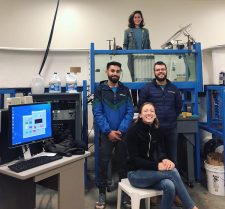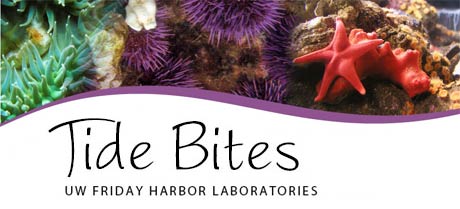Friday Harbor Labs Tide Bites
Posted July 6, 2021 at 4:30 am by Hayley Day
Microplastics and Mussel Poops
By Lyda Harris
Lyda Harris completed her PhD with Emily Carrington in 2020 in the Department of Biology at UW. For her dissertation — much of it done at FHL — she studied 1) the impacts of microplastic vs silt on marine mussel filtration rates, 2) how microplastics affect the benthic-pelagic coupling role of marine mussels and 3) the growth and spread of marine microplastics research and national plastic policies. Harris is now working as the microplastic postdoctoral fellow at the Seattle Aquarium.
Plastic is a human-created pollutant, pervasive across marine systems and is projected to increase in the future.
Microplastics (plastic < 5 mm) are ubiquitous in marine environments, from surface waters to deep-sea sediments, from sea turtles to plankton, from urban cities to arctic outposts.

Lyda (top), Harsimran (left), Nell (middle), and Jackson (right) standing in front of the laminar flume in Lab 6 at Friday Harbor Labs.
Sounds depressing, and it is, but there is important information we can gather and differences we can make from studying depressing topics like marine plastic pollution.
Motivated by the need to understand the impacts microplastics have on our environment and our lives, I set out on my dissertation research at Friday Harbor Labs.
Along the way I convinced three phenomenal undergrads, Harsimran Gill (co-author), Jackson Fennell and Nell Baumgarten, to spend a week with me in the Flume lab at the labs running experiments, counting microscopic particles and learning to operate new equipment.
Little did we know, we would become experts on mussel poop in the process.
Microplastics are likely transported from surface waters to benthic habitats by biotic and abiotic mechanisms similar to those responsible for plankton transportation such as surface currents, wind, and consumption.
Due to their small size and presence throughout the water column, microplastics are ingested by numerous animals with different lifestyles, which can negatively impact their physiology (e.g. growth, immune response and reproduction).
Ingestion and subsequent digestion and/or excretion can thus affect both the animals and their ecological roles, like benthic-pelagic coupling. In this case, benthic-pelagic coupling is the exchange of nutrients, energy and mass between benthic (seafloor) sediment and pelagic (mid-column) waters, a crucial ecological role of nutrient cycling and energy transfer in marine food webs.
Read more at fhl.uw.edu.
You can support the San Juan Update by doing business with our loyal advertisers, and by making a one-time contribution or a recurring donation.
Categories: Environment, Science











No comments yet. Be the first!
By submitting a comment you grant the San Juan Update a perpetual license to reproduce your words and name/web site in attribution. Inappropriate, irrelevant and contentious comments may not be published at an admin's discretion. Your email is used for verification purposes only, it will never be shared.